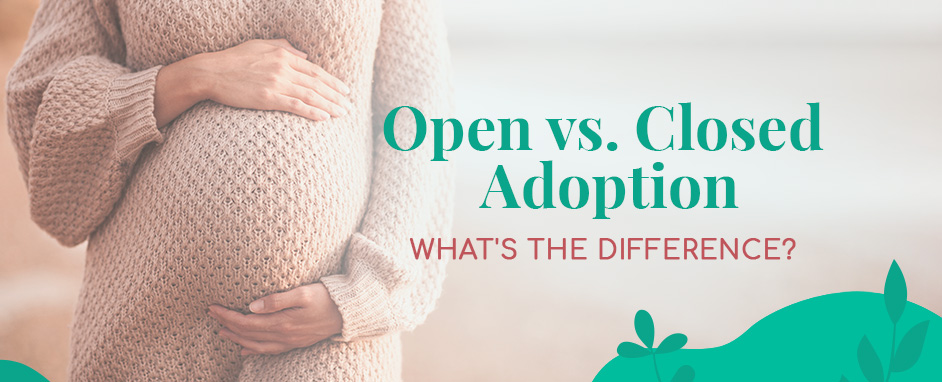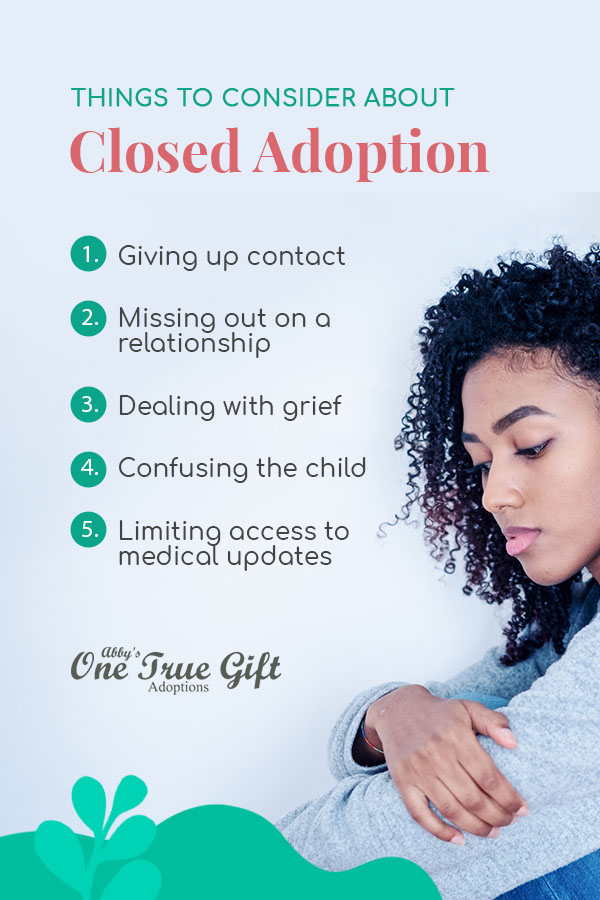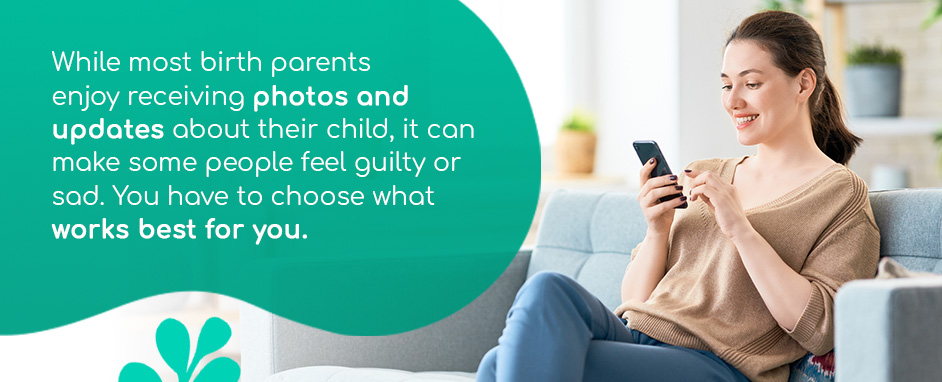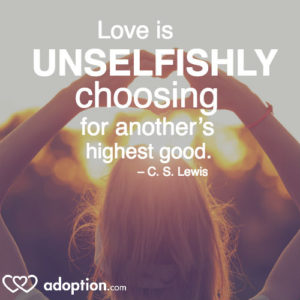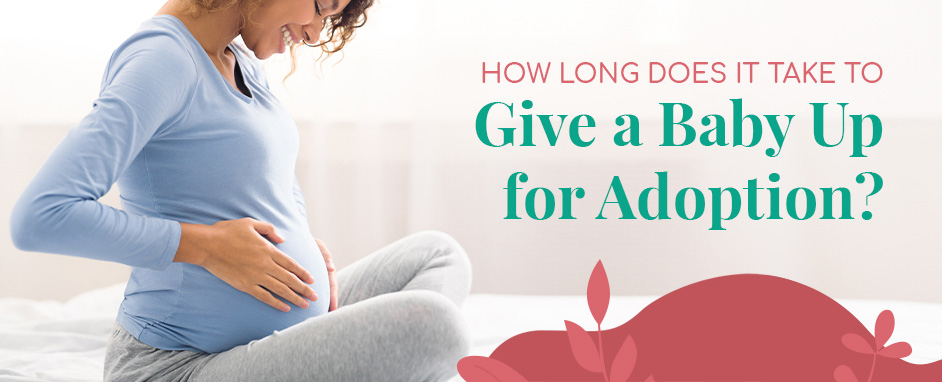May 10, 2023
Open vs. Closed Adoption: What’s the Difference?
In the past, adoption meant the birth mother received zero contact with their child after birth. However, there are now several forms of adoption that allow birth parents to participate in their child’s life. You can choose the level of involvement that you want to have. Learn more about open and closed adoptions to help you choose the best fit for you and your child.
What Is Open Adoption?
Open adoption means adoptive families and birth parents have some contact. Open adoptions come in many varieties because adoptive families and birth parents adapt them based on their unique situations. For instance, an open adoption could mean that the adoptive family regularly sends the birth mother photos of the child. It could also mean that the birth family visits the child multiple times per year. It’s up to you and the adoptive family to decide what kind of relationship you both feel comfortable with.
Here’s what you can typically expect from an open adoption:
- Sharing information: The birth mother and adoptive family exchange contact information to keep in touch before, during and after the adoption process.
- Meeting the adoptive family: Before the baby arrives, birth mothers typically meet the adoptive family several times to get to know them and ensure their adoption preferences align.
- Creating an adoption plan: The birth mother and adoptive family work together to create an open adoption agreement that outlines how they will communicate and interact throughout the child’s life. It’s important for both sides to be honest about what they’re willing and able to do. Once the adoption is finalized, both parties must honor the open adoption rules they created.
Benefits of Open Adoption
Like all forms of adoption, open adoption has pros and cons. Here are the advantages of open adoption to help inform your decision:
- Making peace with your decision: The open adoption process allows you to meet the adoptive family and really get to know them before the adoption is finalized. For many birth mothers, this provides peace of mind that they’re making the right decision.
- Overcoming your emotions: Birth parents often experience grief and loss after placing their child up for adoption. With open adoption, you have the support of the adoptive family to help you cope. Seeing that your child is in a safe and loving home can also provide a lot of comfort.
- Building a relationship with your child: You don’t have to choose between all or nothing with open adoption. You can still participate in your child’s life without the responsibility of providing their care.
- Bonding with the adoptive family: Throughout the adoption process, it can sometimes feel like you’re trusting strangers to love and care for your child. With open adoption, you get a relationship with your child and their adoptive parents. You can get to know them and see how well they’re raising your child.
- Explaining your decision: It’s common for adopted children to wonder why their birth parents chose adoption in the first place. With open adoption, you can reassure them that you made the decision out of love with their best interest in mind. You can also answer any other questions they have about their family background.
- Strengthening your child’s self-esteem: Children of open adoptions feel a sense of identity and belonging that helps promote their confidence and self-worth. They often find it easier to come to terms with being adopted.
- Providing important medical information: Open adoptions allow the birth family to warn their child about hereditary diseases that appear after the adoption is finalized.
Things to Consider About Open Adoption
Choosing adoption is never easy. Here are some challenges associated with an open adoption:
- Making a lifelong commitment: If you’re considering adoption, you already know that raising a child is a big responsibility. Bonding with them through open adoption is also a significant commitment. Make sure you’re willing and able to provide the time and attention to maintain your relationship.
- Interacting with the adoptive family: There are ups and downs to any relationship, including the one you may have with your child’s adoptive parents. Establishing a routine and boundaries that make everyone feel comfortable takes time. There may be moments of frustration and miscommunication along the way, but it often gets easier after a while.
- Reliving the pain: Watching your child grow up with another family can be challenging for some birth mothers. It can feel like you’re reliving the pain of “giving them away” every time you visit. Some parents prefer a clean break so they can heal and move on with their lives.
What Is Closed Adoption?
In a closed adoption, the birth mother and adoptive family typically never meet or even exchange names. An adoption agency matches the birth mother with an adoptive family and carries out the adoption after the birth. You have no contact with the child or their adoptive parents once the adoption is finalized. Any identifying information in closed adoption records is sealed and remains confidential unless the court gives you access.
Although they’ve become less common, there is no shame in choosing a closed adoption. You must make the best choice for your situation.
Here’s what you can typically expect from a closed adoption:
- No information exchange: The birth mother and adoptive family may communicate briefly, but their identifying information is kept private.
- Privacy for both parties: The adoption agency typically handles any communication or exchange of information to ensure that the birth mother and adoptive family maintain their privacy.
- No contact: Once the adoption is finalized, there are no visits, phone calls, pictures or any other forms of communication between the birth mother and adoptive family.
Benefits of Closed Adoption
Closed adoptions also have advantages and disadvantages. Here are the pros of a closed adoption to help you make a confident decision:
- Gaining closure: Watching their child grow up with another family causes too much distress for some people. Closed adoption provides closure so you can make peace with your decision. As the birth mother, you’re the only one who knows what you can handle emotionally.
- Providing safety and privacy: Some birth parents choose adoption to help their child escape a dangerous or abusive environment. Closed adoptions allow the birth mother to keep her pregnancy and adoption private to protect herself and the child.
- Giving your child a better life: Many birth mothers choose adoption to give their children a better future than they can provide. With a closed adoption, the adoptive family takes all the responsibility to provide the care and attention that your child needs.
Things to Consider About Closed Adoption
All forms of adoption have hardships. Here are some challenges associated with closed adoption:
- Giving up contact: Once an adoption is finalized, it’s much more challenging to increase contact than decrease it. Birth mothers that start with an open adoption can reduce contact anytime. To increase contact with a closed adoption, you would have to come to an agreement with the adoptive family, which isn’t guaranteed.
- Missing out on a relationship: With a closed adoption, you forfeit the opportunity to have a relationship with your child and their adoptive parents.
- Dealing with grief: Some birth mothers find it painful to watch another family raise their child. Other women find it comforting to see their child is happy, healthy and loved. Choose the option that will help you deal with your emotions.
- Confusing the child: With a closed adoption, the child may struggle with unanswered questions about their birth family’s background and why they were “given away.” They may have trouble forming an identity and building self-esteem.
- Limiting access to medical updates: The child and adoptive parents won’t have access to potentially useful medical information once the adoption is finalized.
What Is Semi-Open Adoption?
A semi-open adoption is a mix between a closed and open adoption. In many cases, the birth mother receives updates and pictures of the child without being actively involved in their life. The rules of a semi-open adoption vary based on what you and the adoptive family decide. Some parties send photos and letters through their adoption agency, and others feel comfortable interacting by phone and email.
A semi-open adoption is a potential solution for birth mothers that want some contact with their child without the responsibility of an open relationship.
Here’s what you can typically expect from a semi-open adoption:
- Initial interactions: The birth mother and adoptive family will have several opportunities to speak and get to know each other.
- Agreeing on the terms: Both parties will work together to create a semi-open adoption plan they feel comfortable with. They’ll discuss the type and frequency of communication they want to have throughout the child’s life.
- Receiving updates: When the adoption is finalized, the birth mother and adoptive family will communicate according to their agreement.
Benefits of Semi-Open Adoption
A semi-open adoption is another option that might work for your family. Here are the advantages to help you decide:
- Meeting your needs: Like open adoption, a semi-open adoption lets you choose how much contact you want to have with your child. You can work with the adoptive family to decide how you will give and receive information.
- Providing answers: If you want to, you can answer any questions your child has about their adoption and family history. You can also provide relevant updates about your family’s health that could impact your child.
- Receiving updates: With semi-open adoption, you can stay up to date on what’s happening in your child’s life without committing to a full relationship. You also have the opportunity to share your feelings and explain your decision to help you and your child cope.
- Maintaining your distance: You can protect your privacy by sending and receiving information through the adoption agency.
- Allowing contact in the future: Semi-open adoptions keep the lines of communication open so your child can reach out if they desire more contact as they get older. Otherwise, they may have a hard time finding you.
Things to Consider About Semi-Open Adoption
Although there are many pros to semi-open adoption, there are also a few cons. Consider these disadvantages before you make your final decision:
- Waiting for updates: Unless you create a schedule in your adoption agreement, you may not receive updates regularly.
- Experiencing emotional distress: While most birth parents enjoy receiving photos and updates about their child, it can make some people feel guilty or sad that they’re not more involved. They would rather interact with their child personally or distance themselves completely. You have to choose what works best for you.
- Relying on a third party: It’s common for an adoption agency or third-party mediator to handle the communication in semi-open adoptions. If that organization closes, you could lose contact with the adoptive family. Ensure you have a backup plan in your adoption agreement to avoid this risk.
Can You Change Your Mind About Closed and Open Adoptions?
You can change your mind about closed and open adoption depending on which option you’ve chosen and what stage of the process you’re in. Throughout your pregnancy, you can change your mind at any point. Whether you want to open a closed adoption or decide against adoption altogether, nothing is final until you sign the relinquishment papers.
Changing the adoption status becomes challenging once your child is born and you’ve finalized the adoption paperwork. At this point, you no longer have the option to parent the child yourself. However, you may be able to switch from semi-open to open. If you’ve chosen a closed adoption, you’ll most likely have to wait until the child becomes an adult to see if they’re interested in contacting you.
When considering different types of adoption options, remember that you can always choose less contact, but it’s up to the adoptive family to allow more interaction. If you’re worried you might change your mind, open adoption provides the most flexibility throughout the child’s life.
Choosing adoption is difficult, but there’s no shame in doing what’s best for you and your child.
Learn More About Adoption
If you’re considering adoption, it’s important to take your time and understand all the options before you make a decision. Adoption agreements are flexible, so you can create a plan that works best for your situation.
At Abby’s One True Gift private adoption center, our compassionate professionals will get to know you to make the process as personalized and comfortable as possible. We’ll help match you with adoptive families that align with your adoption preferences. You can speak with as many families as you like, and we’ll provide any additional information you need to make a confident choice.
Adoption is a selfless decision to give your child a better future. Request more information or start a live chat to determine if adoption is right for you. You can also text us 24/7 at 515-778-2341 to talk through your options.
